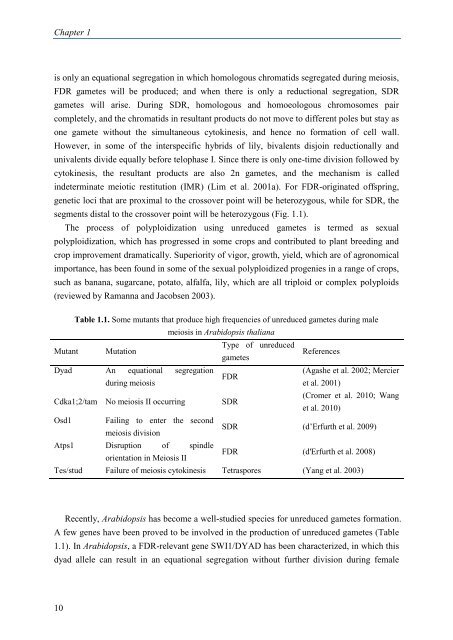A molecular cytogenetic analysis of chromosome behavior in Lilium ...
A molecular cytogenetic analysis of chromosome behavior in Lilium ...
A molecular cytogenetic analysis of chromosome behavior in Lilium ...
You also want an ePaper? Increase the reach of your titles
YUMPU automatically turns print PDFs into web optimized ePapers that Google loves.
Chapter 1is only an equational segregation <strong>in</strong> which homologous chromatids segregated dur<strong>in</strong>g meiosis,FDR gametes will be produced; and when there is only a reductional segregation, SDRgametes will arise. Dur<strong>in</strong>g SDR, homologous and homoeologous <strong>chromosome</strong>s paircompletely, and the chromatids <strong>in</strong> resultant products do not move to different poles but stay asone gamete without the simultaneous cytok<strong>in</strong>esis, and hence no formation <strong>of</strong> cell wall.However, <strong>in</strong> some <strong>of</strong> the <strong>in</strong>terspecific hybrids <strong>of</strong> lily, bivalents disjo<strong>in</strong> reductionally andunivalents divide equally before telophase I. S<strong>in</strong>ce there is only one-time division followed bycytok<strong>in</strong>esis, the resultant products are also 2n gametes, and the mechanism is called<strong>in</strong>determ<strong>in</strong>ate meiotic restitution (IMR) (Lim et al. 2001a). For FDR-orig<strong>in</strong>ated <strong>of</strong>fspr<strong>in</strong>g,genetic loci that are proximal to the crossover po<strong>in</strong>t will be heterozygous, while for SDR, thesegments distal to the crossover po<strong>in</strong>t will be heterozygous (Fig. 1.1).The process <strong>of</strong> polyploidization us<strong>in</strong>g unreduced gametes is termed as sexualpolyploidization, which has progressed <strong>in</strong> some crops and contributed to plant breed<strong>in</strong>g andcrop improvement dramatically. Superiority <strong>of</strong> vigor, growth, yield, which are <strong>of</strong> agronomicalimportance, has been found <strong>in</strong> some <strong>of</strong> the sexual polyploidized progenies <strong>in</strong> a range <strong>of</strong> crops,such as banana, sugarcane, potato, alfalfa, lily, which are all triploid or complex polyploids(reviewed by Ramanna and Jacobsen 2003).Table 1.1. Some mutants that produce high frequencies <strong>of</strong> unreduced gametes dur<strong>in</strong>g malemeiosis <strong>in</strong> Arabidopsis thalianaMutant MutationType <strong>of</strong> unreducedgametesReferencesDyad An equational segregation(Agashe et al. 2002; MercierFDRdur<strong>in</strong>g meiosiset al. 2001)Cdka1;2/tam No meiosis II occurr<strong>in</strong>g SDR(Cromer et al. 2010; Wanget al. 2010)Osd1 Fail<strong>in</strong>g to enter the secondmeiosis divisionSDR (d’Erfurth et al. 2009)Atps1 Disruption <strong>of</strong> sp<strong>in</strong>dleorientation <strong>in</strong> Meiosis IIFDR (d'Erfurth et al. 2008)Tes/stud Failure <strong>of</strong> meiosis cytok<strong>in</strong>esis Tetraspores (Yang et al. 2003)Recently, Arabidopsis has become a well-studied species for unreduced gametes formation.A few genes have been proved to be <strong>in</strong>volved <strong>in</strong> the production <strong>of</strong> unreduced gametes (Table1.1). In Arabidopsis, a FDR-relevant gene SWI1/DYAD has been characterized, <strong>in</strong> which thisdyad allele can result <strong>in</strong> an equational segregation without further division dur<strong>in</strong>g female10














